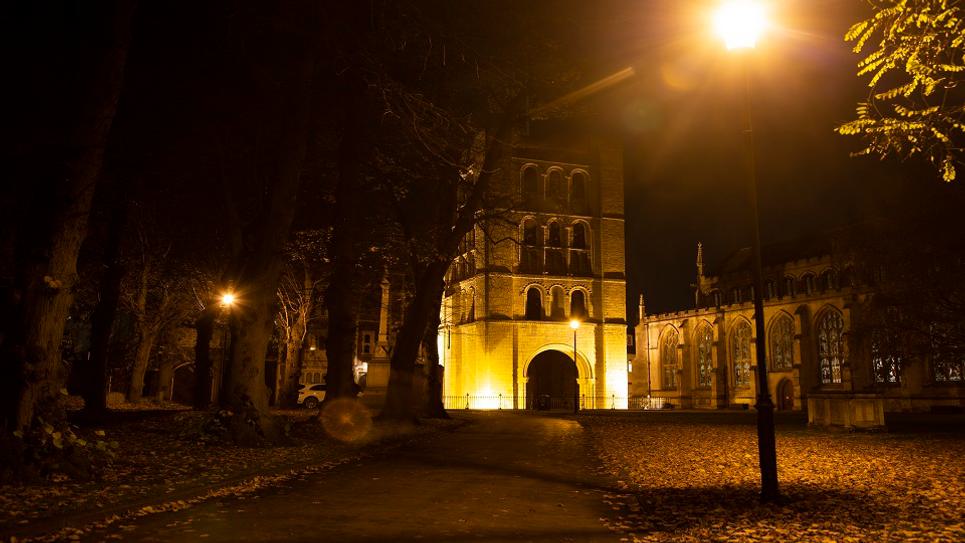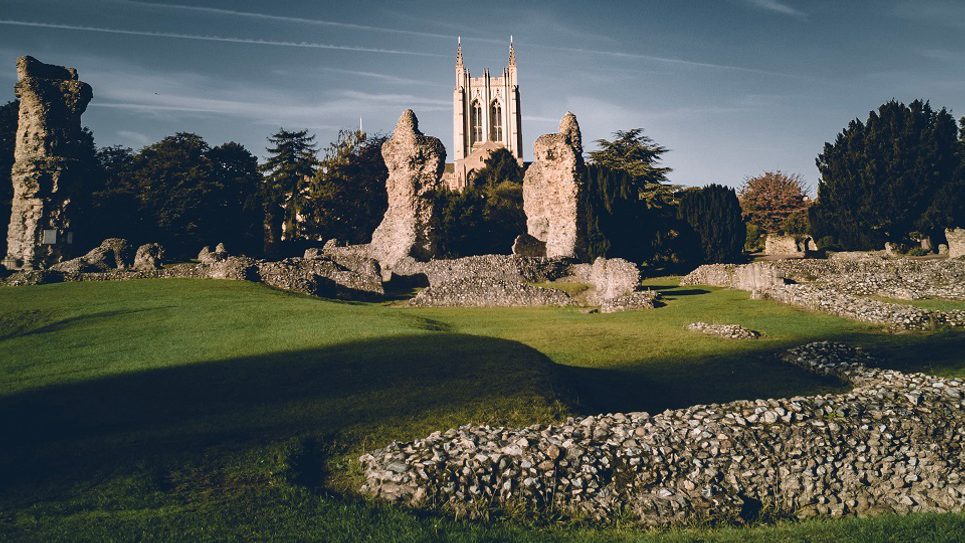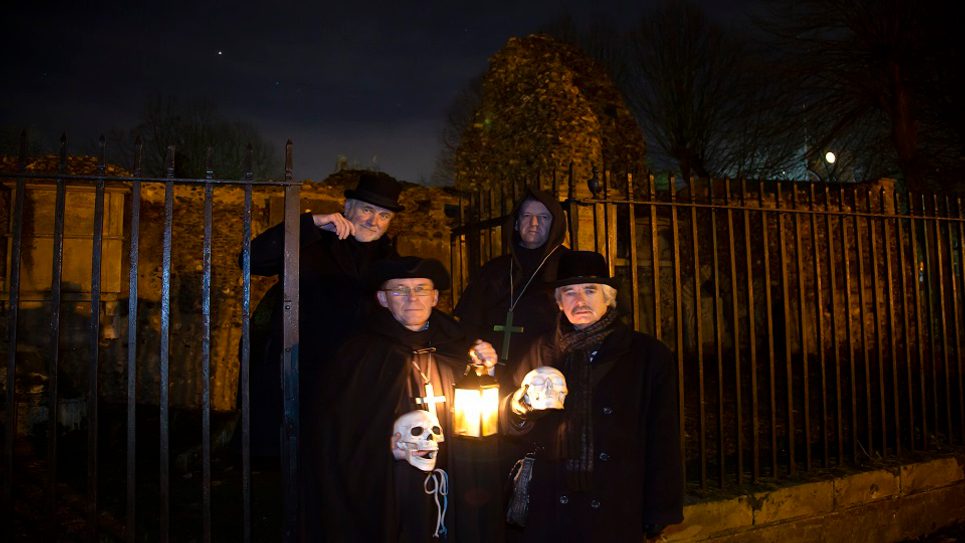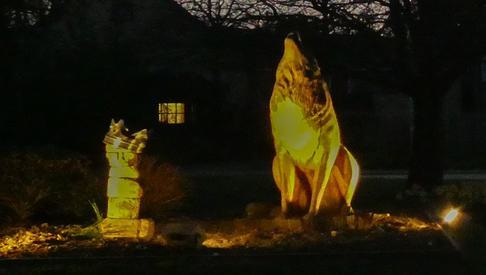
Back to Blogs
Discover
Haunted Bury St Edmunds
From ghostly medieval monks to the infamous Grey Lady, this historical town offers chills and thrills galore. Bury St Edmunds in Suffolk is known as one of the most haunted towns in England!
The Great Churchyard

Photo: Phil Morley
Bury St Edmunds in Suffolk is known as one of the most haunted towns in England. The town's most famous ghostly (undead) resident is The Grey Lady.
She is said to appear in St Edmundsbury Cathedral's Great Churchyard annually on 24 February at 11pm.
The Grey Lady, has also been sighted at the Abbey Ruins, St Saviours Hospital ruins, the Priory Hotel, the Theatre Royal Bury St Edmunds, in shops on Abbeygate Street, in buildings on Angel Hill, and in the cellars of the 16th century Cupola House, now Sakura, on The Traverse.
St Saviours Hospital Site
The mysterious Grey Lady has also been spotted at the site of the former St Saviours Hospital, near the town’s railway station.
St Saviours in Fordham Road was founded in 1184-85 by Abbot Sampson and was where elderly monks from the Abbey of St Edmund were treated. One of five such hospitals in Bury St Edmunds, it also offered a place to rest for weary travellers, including the pilgrims on their way to the Shrine of Edmund in the Abbey itself.
Some believe the ghost is a nun linked to the death of the Duke of Gloucester, who was allegedly murdered in St Saviours Hospital in 1447. There is a plaque recording the death of Humphrey, Duke of Gloucester, uncle of Henry VI.
According to local tales, it was this nun, named Maude Carew, who killed Gloucester (and not the Duke of Suffolk, as portrayed in Shakespeare’s Henry VI, Part II). But this was recently debunked by Historian Dr Francis Young in his Blog The Ghost of Maude Carew. Other tales suggest she is a medieval nun who was punished with execution for a liaison with a monk at the Abbey.
Whoever our Grey Lady is, she is the town’s most frequently spotted spirit.
The Abbey Ruins

Photo: Jon Miles
Apparitions of the Abbey’s Benedictine monks are frequently seen walking around the grounds of The Abbey and through surrounding buildings.
In 1961, two men claim to have seen a monk drift down Angel Lane before disappearing through a wall. A year later, a monk was reportedly seen ‘hovering’ in Churchgate Street.
Enid Crossley, a resident of the houses built into the Abbey's West Front, claims a monk appeared in her bedroom several times. Staff in shops on Abbeygate Street have also made claims about sightings of ghostly monks.
Famous ghost writer M R James, who grew up near Bury St Edmunds, had a lifelong interest in the Abbey of St Edmund and although best known for his ghost stories, M R James' work as a medievalist scholar remains highly respected. He became the leading expert on its medieval manuscripts and the history and layout of its great abbey church. His 1895 two-part volume on the church and manuscripts was the single most important piece of research by an individual since the dissolution of the monasteries.
During this research M R James discovered reference in an abbey register in Douai to the burial places of several of the abbots. This led in 1902-3 to excavations in the chapter house revealing the graves of six abbots, five of which can still be seen today. He also became involved in a heated public debate about the authenticity of the ‘St Edmund relics’, the alleged remains of St Edmund held in Toulouse. He doubted their authenticity, and his view was confirmed by scientific research nearly a century later.
Theatre Royal Bury St Edmunds

Photo: Theatre Royal Bury St Edmunds
Theatre Royal Bury St Edmunds is over 200 years old and is the third oldest theatre in England so its seen its fair share of history and stories!
The Grey Lady which haunts several other locations has been frequently spotted here by actors and theatre staff!
Eastgate Street

Photo: Andy Abbott
Visitors to the town in October should keep their eyes peeled for a soldier and a nurse in Victorian dress.
The first reports were made in 1935 by two girls and their mother, who felt a chill as a man and a woman rushed past them on Eastgate Street. A gunshot and a scream were then heard.
Legend has it the woman was a 19th century nurse called Mary Treese, returning from the Crimean War with a wounded soldier she had tended and fallen in love with. Her father, however, disapproved of their relationship and shot the man dead. Their fateful end is said to be played out every year on 20th October on Eastgate Street.
The Nutshell

Photo: Emily Fae
As well as being one of Britain’s smallest pubs, The Nutshell, built in 1844, may also be one of its most haunted.
In 1975, the landlord returned downstairs from the room above the bar, telling patrons he had just seen a small boy sitting by himself and then disappear. And, in fact, it is thought a boy did die here in suspicious circumstances – some say by drowning in a bathtub.
Locals of the Nutshell also claim to have experienced poltergeist activity in the pub, with many blaming glasses shattered and batteries drained on the young ghost. Others, however, point the finger at a mummified cat, which hangs over the bar. This cat is said to be cursed, bringing misfortune to anyone who touches it.
Alan Murdie, Chair of the Ghost Club and author of Haunted Bury St Edmunds, says bad luck befell a landlady who tried to clean it as well as a group of servicemen from RAF Honington who kidnapped it as a prank. The landlady lost her job shortly after her cleaning attempt, and the servicemen say they were plagued by fires and accidents until the cat was returned.
During the infamous Witch Trials in Bury St Edmunds, accused witches were taken to a building where The Nutshell pub is today and had their nails or locks of hair. cut off The nails and hair were stored in brown jars in the basement as it was thought that if you were not whole when you died, you wouldn’t be able to come back as a whole witch in the next life!
Cupola House

Cupola House in the Traverse, was built in 1693 as a private home but destroyed by fire in 2012 before being rebuilt. It is now a restaurant called Sakura.
A ghostly Victorian lady dressed in white was spotted in 2000 by a member of staff on the stairs. She stood there for several minutes before disappearing into thin air.
A former landlady claimed that the cellars were an eerie place to visit at night and items would regularly be moved around with a strange eerie presence.
Moyse’s Hall Museum

Once a workhouse, police station and gaol, Moyse’s Hall Museum has been the focus of ghost tales for centuries. The oldest of these stories dates back to 1328, when a woman is recorded as saying she saw ‘a most horrible devil’ in the building’s cellar.
In 1828, shrieks and apparitions were reported after the hanging of the infamous Red Barn murderer William Corder. These only stopped when Corder’s skull was duly buried.
William Corder, of Polstead, near Sudbury, was hanged in Bury St Edmunds in 1828 after being found guilty of murdering his lover Maria Martin in what became known as the Murder in the Red Barn. She was shot and repeatedly stabbed before being buried in a shallow grave in a barn.
Following his execution, a death mask of Corder was made and his skin was tanned and used to bind an account of the murder, which passed into Suffolk folklore. These are on display at the museum.
Take a Ghost Tour!

Brave souls can hear more spine-tingling tales about the town’s eerie goings-on by joining the Ghostly and Macabre Walk, held on various dates on dark autumn and winter evenings from Halloween to the end of March.
As you wind your way around the darkened streets there will be stories of screaming skulls, mysterious ‘monk’ like figures appearing in cellars, burnings, hangings and more, finishing up in the dark and deserted Great Churchyard where the tour guides will recall the stories from the Abbey and the famous Grey Lady.
Beyond Bury St Edmunds - Haunted inhabitants at Melford Hall

Melford Hall in Long Melford and the nearby Bull Hotel both have ghostly inhabitants! Melford Hall has been the scene for many horrific events over the years. Between May and September in 1604, 119 men, women and children were burned during the plague epidemic. The hall is also said to be haunted by the ghost of Countess Rivers. Myth has it, she jumped from a window and drowned in the moat in 1651.
Just a short walk away you will find The Bull hotel, haunted since 1648 when a man named Richard Evered was murdered after a political dispute. Witnesses left him lying in the hallway as they ran to get help, but on their return, his body was gone.
Rougham Airfield

Photo: Ciaran Sage
With it's rich war time history, it is no wonder that the Rougham airfield is said to be haunted!
Bury St Edmunds was home for thousands of American airmen and women during WWII and a visit to Rougham Control Tower Aviation Museum is like taking a trip back in time.
Originally known as RAF Bury St Edmunds, Rougham Airfield, known by the USAAF as Station 468, not only welcomed 3,000 GIs during WWII but the Glenn Miller Orchestra, legendary comedian Bob Hope and Hollywood movie star Clark Gable, who all visited to entertain the troops. It was home for the 322nd Bomb Group and the 94th Bomb Group of the USAAF 8th Airforce, known as the Mighty Eighth, whose contribution to the Allies’ strategic bombing offensive helped turn the tide of war against the Nazis and free occupied Europe.
There have been a number of paranormal groups who have visited the airfield and museum to investigate over the years and many have had some amazing results!
In the Control Room at the very top of the tower, there have been reports of a smell of oil, and a smell of what appears to be very strong perfume. People have also reported what sounds like a prop aircraft flying overhead. In the two nissen hunts, there have been reports of a young spirit boy, who is said to have owned one of the bikes that are on display.
The main tower has had a lot of activity reported. In the first room on the left as you enter the tower, several people have reported feeling very uneasy. Reports of strange lights, people seeing what appears to be feet, and someone left the room after being left alone for only 30 seconds! As you move upstairs, in the large room at the far end, a strong smell of tobacco has been reported by a number of people.
In the main room, at the rear of the ground floor, two people were amazed to see a figure of a man walk across the room and two paranormal investigators caught what appears to be a figure walking across one of the smaller rooms on the first floor. Both claim that they saw nothing while they were there, it was only when they reviewed the footage taken on their mobile phone, that they found the video which you can view on the Rougham Control Tower Aviation Museum's website.
The Haunted Room at Kentwell Hall

The Victorian Room at Kentwell Hall in Long Melford has been known to family members and their servants as the Haunted Room for many years.
It prompted one guest to pen The Kentwell Ballad in 1836.
The Bull Hotel, Long Melford

The ghost of Richard Evered, murdered in The Bull Hotel in Long Melford in 1648 is rumoured to still haunt the hotels halls and corridors.
Two men were having an argument about politics and it got so heated that one stabbed the other. Richard Evered was laid out in the hallway while people went to get help. When they returned his body had disappeared...
Built back in the 1400’s, the hotel still retains lots of original features including its oak beams and Elizabethan fireplace. During the coaching era, the hotel was the principal Posting House of the town and welcomed coaches from London, Norwich, and Bury St Edmunds.
You can enjoy lunch or dinner in The Cordell Restaurant and enjoy your food among the antique carvings.
The Hotel holds regular paranormal evenings.
Book Your Stay!
With so many things to do and ghostly places to explore we know you’ll want to stay longer! Visit our Places to Stay Guide to find accommodation from historical homes to boutique hotels and from cosy bed and breakfasts to unique self-catering.
Related Posts
Related Blogs

News
Spend a Weekend in Haunted…
From ghostly medieval monks to the infamous Grey Lady,…

News
Red Barn Murder
Discover the story of the notorious Red Barn Murder at…

News
Bury St Edmunds' Horrible…
Discover the gruesome tales in Bury St Edmunds' murky…

News
Myths & Legends of Bury St…
With a 1000 year history, Bury St Edmunds & Beyond is…

News
Horrible Histories Creator…
Horrible Histories creator Terry Deary has helped…
Latest news

News
Discover Suffolk's County Flower - the Oxlip
Did you know that Suffolk has a county flower? The Oxlip only grows in some woodland areas of Suffolk, Cambridgeshire and Essex.

News
Quentin Blake ‘The Illustrated Hospital’ exhibition at Bury St Edmunds Museum
A summer exhibition of illustrations by Quentin Blake at Moyse’s Hall Museum, Bury St Edmunds presents a rare opportunity to view a large collection of pieces by one of the nation’s favourite artists.

News
Abbey Project Awarded National Lottery Heritage Fund Grant
The project aims to conserve and protect the ruins; build a visitor centre, west cloister, and network of footpaths; and use digital technology to provide exciting interpretation for all ages and…

News
Walks at Rougham
Rougham Estate offers 18 miles of public footpaths, cycling routes and permissive pathways for you to enjoy.

News
Bury St Edmunds Celebrates English Tourism Week
Bury St Edmunds MP, Jo Churchill, met representatives from the town’s attractions and tour guides involved with the town’s Masters of the Air tourism campaign at Bury St Edmunds Guildhall.

News
Tours Take Off for Masters of The Air
Tours developed by Bury St Edmunds Tour Guides and Bury St Edmunds Guildhall to tie in with the Apple TV Series Masters of The Air so popular more dates are being added.

News
International illustrator David Hughes draws largest exhibition Bury St Edmunds
The largest ever exhibition is now underway at Moyse’s Hall Museum featuring the work of internationally acclaimed illustrator David Hughes.

News
A Taste of Bury St Edmunds and Suffolk
After visiting Suffolk's foodie capital, you'll want to take it with you - here are 5 foodie treats to take home!

News
Doctor Who Stars Coming to Bury St Edmunds to Star in Sherlock Holmes Classic
Who stars Colin Baker, Terry Molloy, and Rosie Baker will star in Hound of The Baskervilles at Bury St Edmunds Theatre Royal



